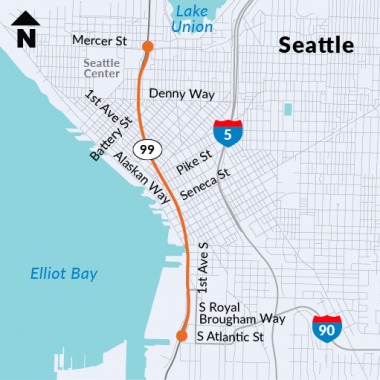In February 2001, a 6.8 magnitude earthquake struck near Seattle, causing several foundations of the Alaskan Way Viaduct to shift as much as five inches. Engineers believe the viaduct would have collapsed had the earthquake lasted a few moments longer. During the next decade, state and local agencies studied more than 90 alternatives to replace the aging viaduct, which carried SR 99 through Seattle. In 2009, a deep-bored tunnel was chosen. One of the advantages of this option was that it allowed the viaduct, which remained safe for daily use, to remain open during most of tunnel construction.
The tunnel boring machine "Bertha" began digging the SR 99 tunnel in 2013. Bertha completed her dig in 2017 and the tunnel opened to drivers on February 4, 2019.
Milestone
February 2001
Nisqually earthquake damaged the viaduct
2009
State and local leaders agreed to replace the waterfront section of the viaduct with a bored tunnel
2010
Seattle Tunnel Partners was chosen as the design-build contractor to build the SR 99 tunnel
July 30, 2013
Tunneling machine "Bertha"—the world's largest-diameter TBM—began digging the tunnel route
April 4, 2017
Bertha completed tunneling, breaking into the receiving pit near Seattle's Space Needle
January 11, 2019
The Alaskan Way Viaduct closed to vehicles forever as crews begin to realign SR 99 with the new tunnel
February 4, 2019
The SR 99 tunnel opened to vehicles
November 9, 2019
Tolling began on the SR 99 tunnel
There are no maps or drawings for this project.
Get tolling information on the Good To Go! pass website.
SR 99 Tunnel Tolling page

